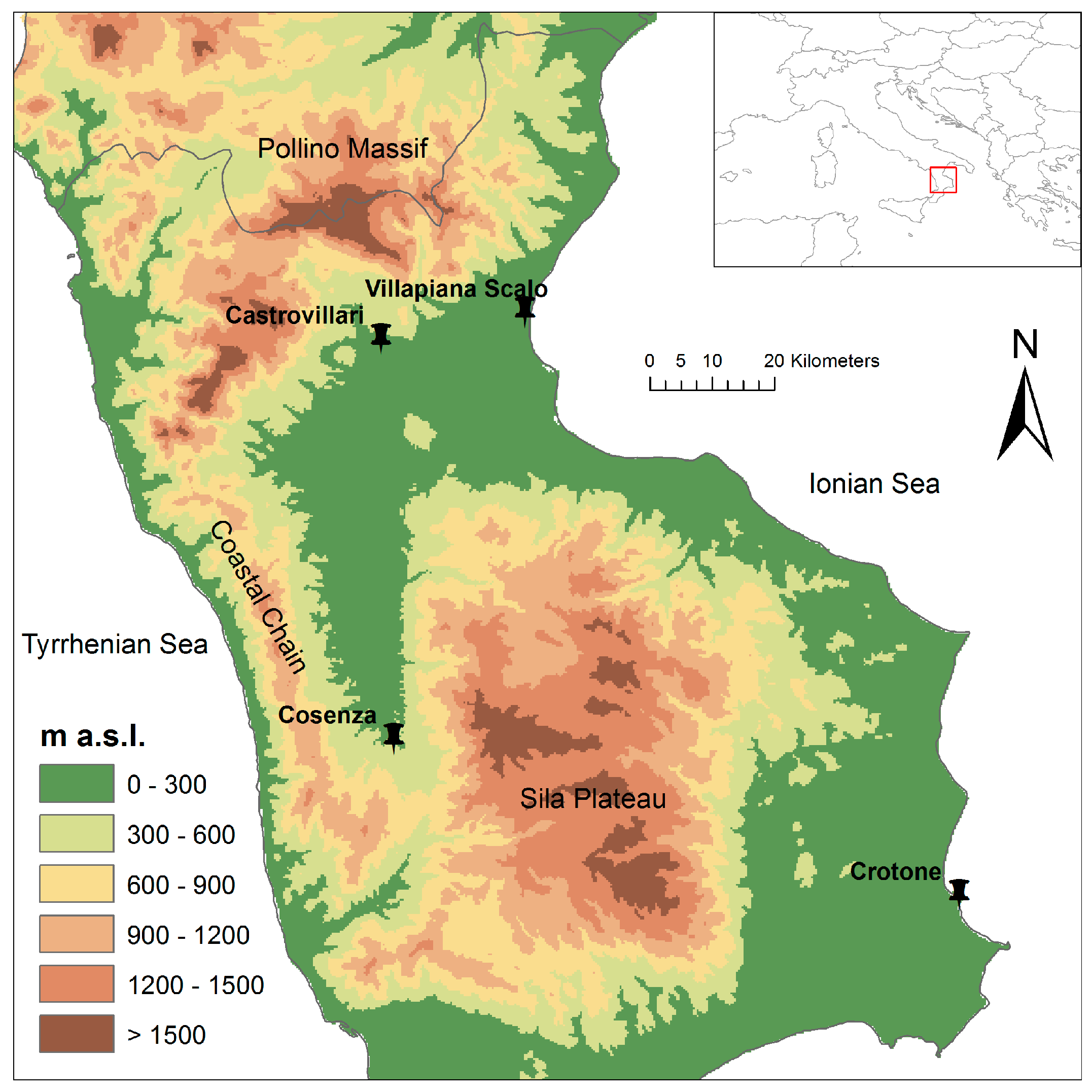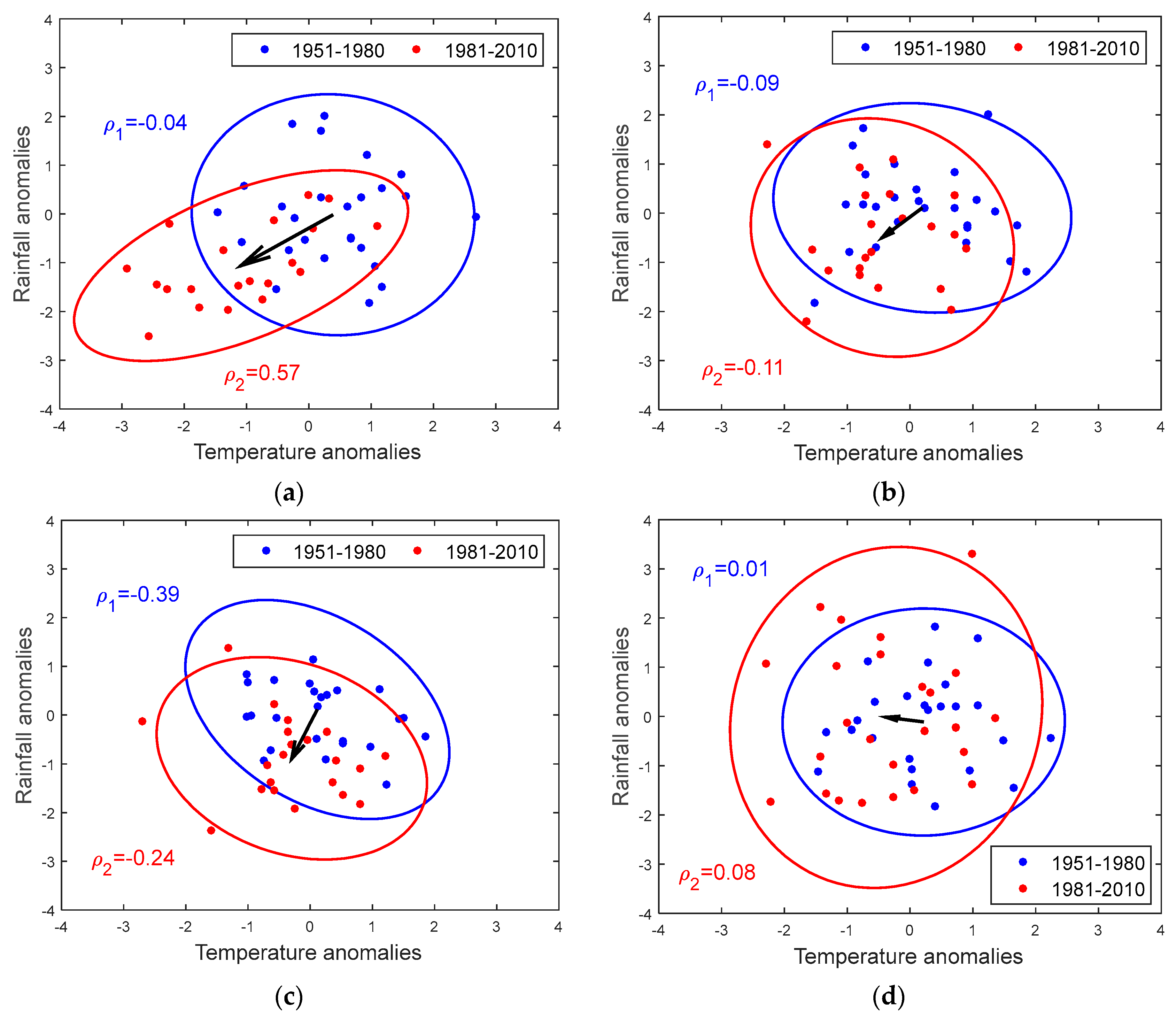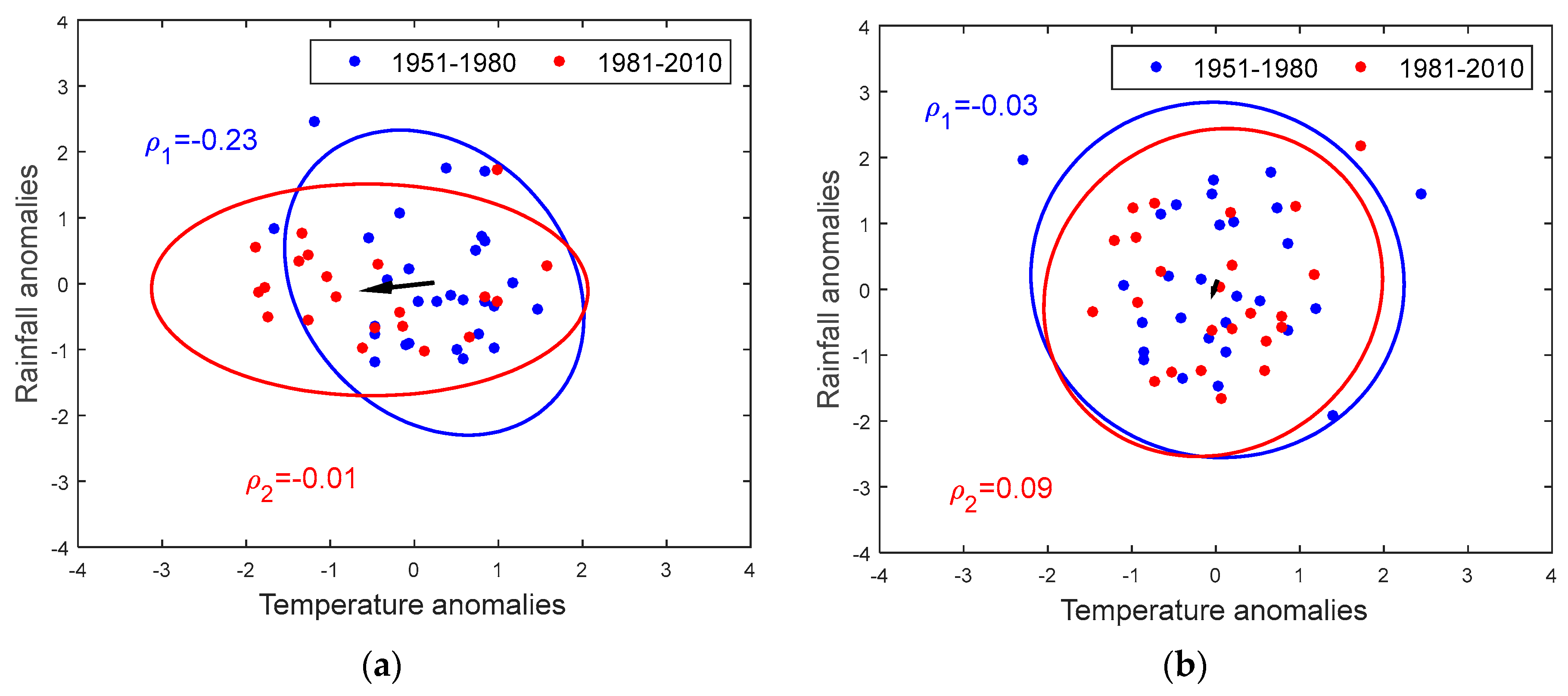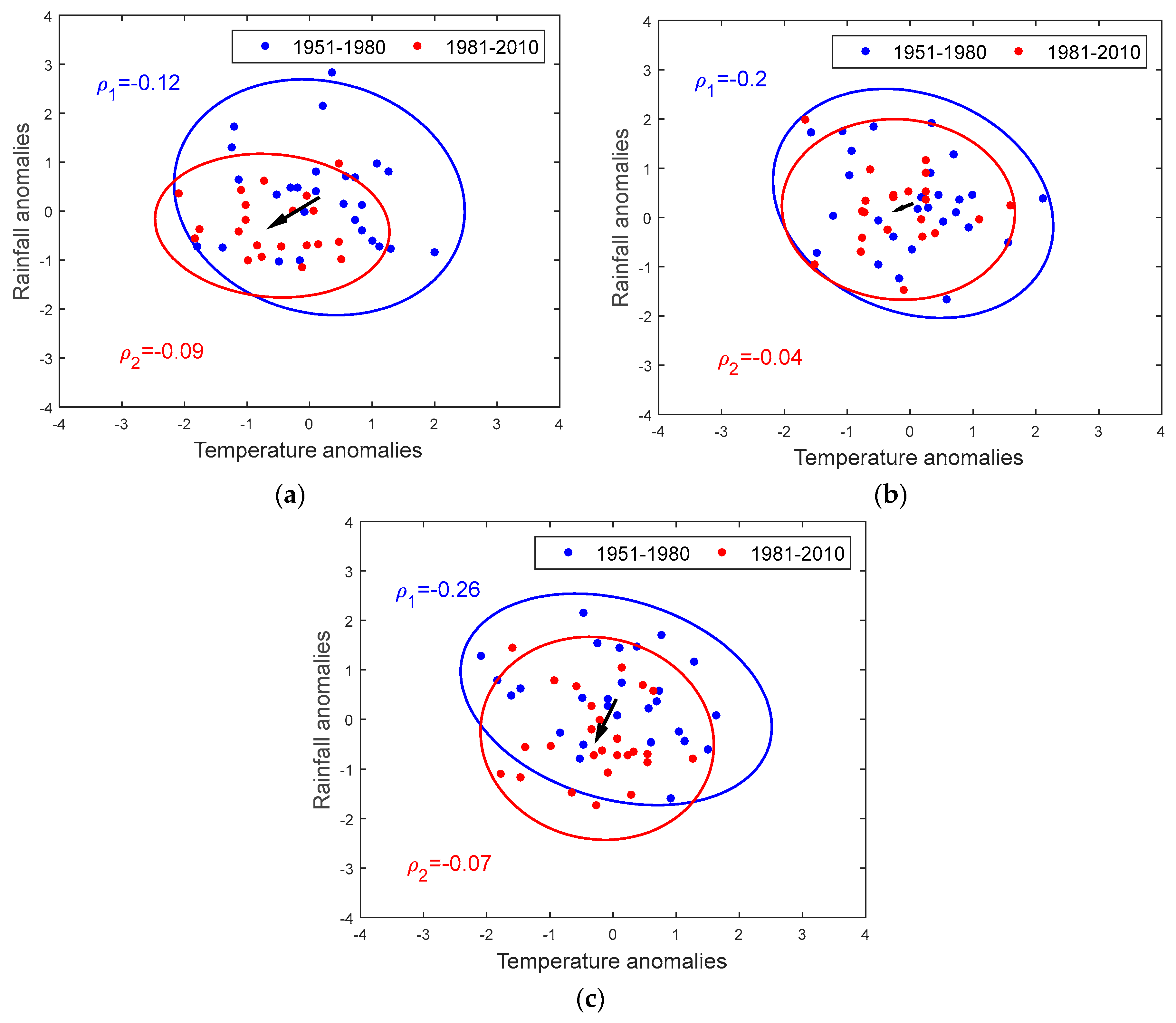Correlation Analysis of Seasonal Temperature and Precipitation in a Region of Southern Italy
Abstract
:1. Introduction
2. Materials and Methods
2.1. Study Area and Data
2.2. Methods
3. Results and Discussion
4. Conclusions
Author Contributions
Conflicts of Interest
References
- Calderini, D.F.; Abeledo, L.G.; Savin, R.; Slafer, G.A. Effect of temperature and carpel size during pre-anthesis on potential grain weight in wheat. J. Agric. Sci. 1999, 132, 453–459. [Google Scholar] [CrossRef]
- Abbate, P.E.; Dardanelli, J.L.; Cantarero, M.G.; Maturano, M.; Melchiori, R.J.M.; Suero, E.E. Climatic and water availability effects on water-use efficiency in wheat. Crop Sci. 2004, 44, 474–483. [Google Scholar] [CrossRef]
- Medori, M.; Michelini, L.; Nogues, I.; Loreto, F.; Calfapietra, C. The impact of root temperature on photosynthesis and isoprene emission in three different plant species. Sci. World J. 2012. [Google Scholar] [CrossRef] [PubMed]
- Caloiero, T. Analysis of rainfall trend in New Zealand. Environ. Earth Sci. 2015, 73, 6297–6310. [Google Scholar] [CrossRef]
- Brunetti, M.; Caloiero, T.; Coscarelli, R.; Gullà, G.; Nanni, T.; Simolo, C. Precipitation variability and change in the Calabria region (Italy) from a high resolution daily dataset. Int. J. Climatol. 2012, 32, 57–73. [Google Scholar] [CrossRef]
- Longobardi, A.; Buttafuoco, G.; Caloiero, T.; Coscarelli, R. Spatial and temporal distribution of precipitation in a Mediterranean area (Southern Italy). Environ. Earth Sci. 2016, 75, 189. [Google Scholar] [CrossRef]
- Mehta, A.V.; Yang, S. Precipitation climatology over Mediterranean Basin from ten years of TRMM measurements. Adv. Geosci. 2008, 17, 87–91. [Google Scholar] [CrossRef]
- Reale, M.; Lionello, P. Synoptic climatology of winter intense precipitation events along the Mediterranean coasts. Nat. Hazards Earth Syst. 2013, 13, 1707–1722. [Google Scholar] [CrossRef]
- Lionello, P.; Giorgi, F. Winter precipitation and cyclones in the Mediterranean region: Future climate scenarios in a regional simulation. Adv. Geosci. 2007, 12, 153–158. [Google Scholar] [CrossRef]
- Brunetti, M.; Maugeri, M.; Monti, F.; Nanni, T. Temperature and precipitation variability in Italy in the last two centuries from homogenised instrumental time series. Int. J. Climatol. 2006, 26, 345–381. [Google Scholar] [CrossRef]
- Longobardi, A.; Villani, P. Trend analysis of annual and seasonal rainfall time series in the Mediterranean area. Int. J. Climatol. 2010, 30, 1538–1546. [Google Scholar] [CrossRef]
- Piccarreta, M.; Capolongo, D.; Boenzi, F. Trend analysis of precipitation and drought in Basilicata from 1923 to 2000 within a Southern Italy context. Int. J. Climatol. 2004, 24, 907–922. [Google Scholar] [CrossRef]
- Liuzzo, L.; Bono, E.; Sammartano, V.; Freni, G. Analysis of spatial and temporal rainfall trends in Sicily during the 1921–2012 period. Theor. Appl. Climatol. 2016, 126, 113–129. [Google Scholar] [CrossRef]
- Caloiero, T.; Buttafuoco, G.; Coscarelli, R.; Ferrari, E. Spatial and temporal characterization of climate at regional scale using homogeneous monthly precipitation and air temperature data: An application in Calabria (southern Italy). Hydrol. Res. 2015, 46, 629–646. [Google Scholar] [CrossRef]
- Klok, E.J.; Tank, A. Updated and extended European dataset of daily climate observations. Int. J. Climatol. 2009, 29, 1182–1191. [Google Scholar] [CrossRef]
- Caloiero, T.; Callegari, G.; Cantasano, N.; Coletta, V.; Pellicone, G.; Veltri, A. Bioclimatic Analysis in a Region of Southern Italy (Calabria). Plant Biosyst. 2015. [Google Scholar] [CrossRef]
- Liang, K.; Bai, P.; Li, J.J.; Liu, C.M. Variability of temperature extremes in the Yellow River basin during 1961–2011. Quat. Int. 2014, 336, 52–64. [Google Scholar] [CrossRef]
- Caloiero, T. Trend of monthly temperature and daily extreme temperature during 1951–2012 in New Zealand. Theor. Appl. Climatol. 2016. [Google Scholar] [CrossRef]
- Salinger, M.J.; Griffiths, G.M. Trends in New Zealand daily temperature and rainfall extremes. Int. J. Climatol. 2001, 21, 1437–1452. [Google Scholar] [CrossRef]
- Donat, M.G.; Alexander, L.V. The shifting probability distribution of global daytime and night-time temperatures. Geophys. Res. Lett. 2012, 39, L14707. [Google Scholar] [CrossRef]
- Giorgi, F. Climate change hot-spots. Geophys. Res. Lett. 2006, 33, L08707. [Google Scholar] [CrossRef]
- Simolo, C.; Brunetti, M.; Maugeri, M.; Nanni, T.; Speranza, A. Understanding climate change–induced variations in daily temperature distributions over Italy. J. Geophys. Res. 2010, 115, D22110. [Google Scholar] [CrossRef]
- Caloiero, T.; Coscarelli, R.; Ferrari, E.; Sirangelo, B. Trend analysis of monthly mean values and extreme indices of daily temperature in a region of southern Italy. Int. J. Climatol. 2017, 37, 284–297. [Google Scholar] [CrossRef]
- Tanarhte, M.; Hadjinicolaou, P.; Lelieveld, J. Intercomparison of temperature and precipitation data sets based on observations in the Mediterranean and the Middle East. J. Geophys. Res. 2012, 117. [Google Scholar] [CrossRef]
- Rajeevan, M.; Pai, D.S.; Thapliyal, V. Spatial and temporal relationships between global land surface air temperature anomalies and Indian summer monsoon rainfall. Meteorol. Atmos. Phys. 1998, 66, 157–171. [Google Scholar] [CrossRef]
- Huang, Y.; Cai, J.; Yin, H.; Cai, M. Correlation of precipitation to temperature variation in the Huanghe River (Yellow River) basin during 1957–2006. J. Hydrol. 2009, 372, 1–8. [Google Scholar] [CrossRef]
- Cong, R.G.; Brady, M. The Interdependence between Rainfall and Temperature: Copula Analyses. Sci. World J. 2012. [Google Scholar] [CrossRef] [PubMed]
- Péguy, C.P. Une tentative de délimitation et de schématisation des climats intertropicaux. Rev. Geogr. 1961, 36, 1–6. [Google Scholar] [CrossRef]
- Craddock, J.M. Methods of comparing annual rainfall records for climatic purposes. Weather 1979, 34, 332–346. [Google Scholar] [CrossRef]
- Wilks, D.S. Statistical Methods in the Atmospheric Sciences, 2nd ed.; International Geophysics Series; Academic Press: Cambridge, MA, USA, 1995. [Google Scholar]
- Rodrigo, F.S. On the covariability of seasonal temperature and precipitation in Spain, 1956–2005. Int. J. Climatol. 2014, 35, 3362–3370. [Google Scholar] [CrossRef]
- Sirangelo, B.; Ferrari, E. Probabilistic analysis of the variation of water resources availability due to rainfall change in the Crati basin (Italy). In Global Change: Facing Risks and Threats to Water Resources; Servat, E., Demuth, S., Dezetter, A., Daniell, T., Ferrari, E., Ijjaali, M., Jabrane, R., van Lanen, H., Huang, Y., Eds.; IAHS Publication, N° 340; IAHS Press: Wallingford, UK, 2010; pp. 142–149. [Google Scholar]
- Ferrari, E.; Terranova, O. Non-parametric detection of trends and change point years in monthly and annual rainfalls. In Proceedings of the 1st Italian-Russian Workshop on New Trend in Hydrology, CNR-IRPI, Rende, Italy, 24–26 September 2002; pp. 177–188. [Google Scholar]
- Kottegoda, N.T.; Rosso, R. Applied Statistics for Civil and Environmental Engineers, 2nd ed.; Wiley & Sons: New York, NY, USA, 2008. [Google Scholar]
- Hotelling, H. The generalization of Student’s ratio. Ann. Math. Stat. 1931, 2, 360–378. [Google Scholar] [CrossRef]




| Missing Data (%) | |||||||
|---|---|---|---|---|---|---|---|
| Monthly Temperature | Monthly Rainfall | ||||||
| Code | Station | 1951–1980 | 1981–2010 | Whole Period | 1951–1980 | 1981–2010 | Whole Period |
| 930 | Villapiana Scalo | 0 | 0 | 0 | 5.8 | 13.6 | 9.7 |
| 1010 | Cosenza | 0 | 0.3 | 0.1 | 7.5 | 9.7 | 8.5 |
| 1180 | Castrovillari | 0 | 4.7 | 2.4 | 5.3 | 9.4 | 7.4 |
| 1680 | Crotone | 3.1 | 5.3 | 4.2 | 8.9 | 11.1 | 10.0 |
| Season | Station | (°C) | (°C) | ||
|---|---|---|---|---|---|
| Winter | 930 | 10.3 | 0.8 | 231.9 | 81.3 |
| 1010 | 8.6 | 1.1 | 405.4 | 149.0 | |
| 1180 | 9.2 | 1.2 | 371.6 | 134.7 | |
| 1680 | 11.3 | 0.8 | 234.9 | 89.8 | |
| Spring | 930 | 14.9 | 0.9 | 125.2 | 69.0 |
| 1010 | 14.1 | 1.4 | 210.1 | 74.3 | |
| 1180 | 14.6 | 1.2 | 178.0 | 71.2 | |
| 1680 | 15.4 | 1.4 | 117.1 | 60.3 | |
| Summer | 930 | 24.6 | 1.2 | 41.4 | 26.5 |
| 1010 | 24.0 | 1.1 | 64.4 | 36.4 | |
| 1180 | 24.8 | 1.3 | 78.2 | 57.3 | |
| 1680 | 25.3 | 1.1 | 31.9 | 27.7 | |
| Autumn | 930 | 18.5 | 0.9 | 203.5 | 115.1 |
| 1010 | 17.2 | 1.2 | 260.0 | 99.4 | |
| 1180 | 17.8 | 1.1 | 250.1 | 92.1 | |
| 1680 | 19.4 | 0.8 | 250.2 | 117.1 |
| Season | Gauges | 1951–1980 | 1981–2010 | ||
|---|---|---|---|---|---|
| Temperature | Rainfall | Temperature | Rainfall | ||
| Winter | 930 | 0.229 | 0.249 | 0.189 | 0.473 |
| 1010 | 0.474 | 0.325 | 0.425 | 0.196 | |
| 1180 | 0.472 | 0.707 | 0.392 | 0.224 | |
| 1680 | 0.249 | 0.279 | 0.279 | 0.443 | |
| Spring | 930 | 0.673 | 0.490 | 0.490 | 0.309 |
| 1010 | 0.349 | 0.477 | 0.257 | 0.321 | |
| 1180 | 0.303 | 0.305 | 0.387 | 0.807 | |
| 1680 | 0.790 | 0.899 | 0.261 | 0.218 | |
| Summer | 930 | 0.216 | 0.406 | 1.047 | 0.791 |
| 1010 | 0.264 | 0.351 | 0.309 | 1.154 | |
| 1180 | 0.321 | 1.229 | 0.576 | 0.448 | |
| 1680 | 0.428 | 2.053 | 1.027 | 1.240 | |
| Autumn | 930 | 0.344 | 0.491 | 0.338 | 0.434 |
| 1010 | 0.242 | 0.276 | 0.442 | 0.223 | |
| 1180 | 0.351 | 0.196 | 0.405 | 0.695 | |
| 1680 | 0.346 | 1.015 | 0.190 | 0.863 | |
| Season | Site | Translations | Rotations | Deformations | |
|---|---|---|---|---|---|
| ϑ (°) | |||||
| Winter | 930 | −1.5 | −1.0 | 109.1 | −16 |
| 1010 | −0.6 | −0.6 | −51.4 | 0 | |
| 1180 | −0.4 | −1.0 | 9.5 | 1 | |
| 1680 | −0.6 | +0.1 | 1.8 | 61 | |
| Spring | 930 | −0.8 | −0.1 | 69.2 | 4 |
| 1010 | −0.1 | −0.2 | −14.9 | −17 | |
| Autumn | 930 | −0.8 | −0.6 | 43.5 | −59 |
| 1010 | −0.2 | −0.1 | 13.5 | −36 | |
| 1180 | −0.3 | −0.8 | −42.8 | −27 | |
| Season | Site | H | t(T) | t(R) |
|---|---|---|---|---|
| Winter | 930 | 30.28 | −4.84 | −3.91 |
| 1010 | 11.66 | −2.39 | −2.19 | |
| 1180 | 23.77 | −1.59 | −3.88 | |
| 1680 | 4.91 | −2.18 | +0.28 | |
| Spring | 930 | 8.70 | −2.85 | −0.48 |
| 1010 | 0.46 | −0.21 | −0.65 | |
| Autumn | 930 | 17.39 | −3.05 | −2.51 |
| 1010 | 1.37 | −0.98 | −0.51 | |
| 1180 | 14.78 | −1.24 | −3.36 |
© 2018 by the authors. Licensee MDPI, Basel, Switzerland. This article is an open access article distributed under the terms and conditions of the Creative Commons Attribution (CC BY) license (http://creativecommons.org/licenses/by/4.0/).
Share and Cite
Ferrari, E.; Coscarelli, R.; Sirangelo, B. Correlation Analysis of Seasonal Temperature and Precipitation in a Region of Southern Italy. Geosciences 2018, 8, 160. https://doi.org/10.3390/geosciences8050160
Ferrari E, Coscarelli R, Sirangelo B. Correlation Analysis of Seasonal Temperature and Precipitation in a Region of Southern Italy. Geosciences. 2018; 8(5):160. https://doi.org/10.3390/geosciences8050160
Chicago/Turabian StyleFerrari, Ennio, Roberto Coscarelli, and Beniamino Sirangelo. 2018. "Correlation Analysis of Seasonal Temperature and Precipitation in a Region of Southern Italy" Geosciences 8, no. 5: 160. https://doi.org/10.3390/geosciences8050160





